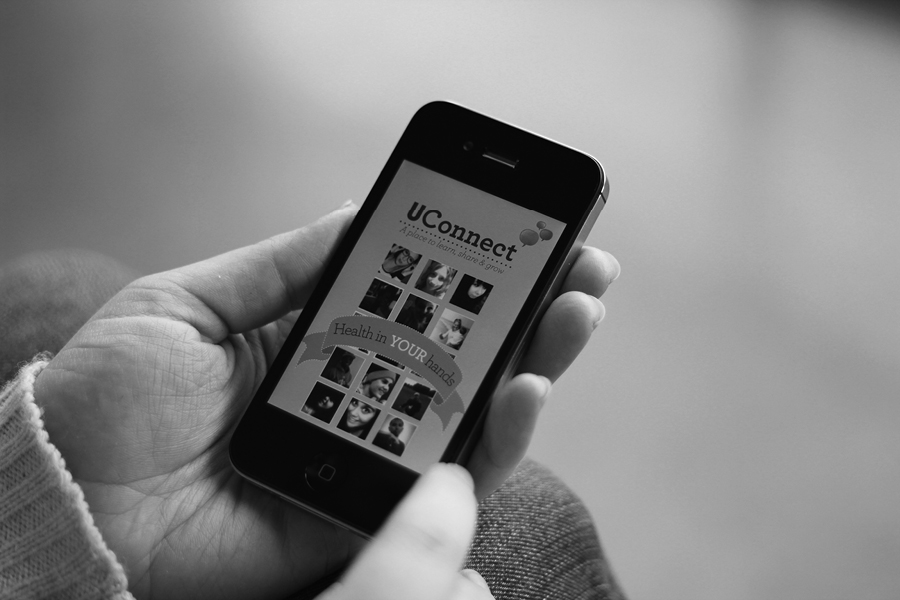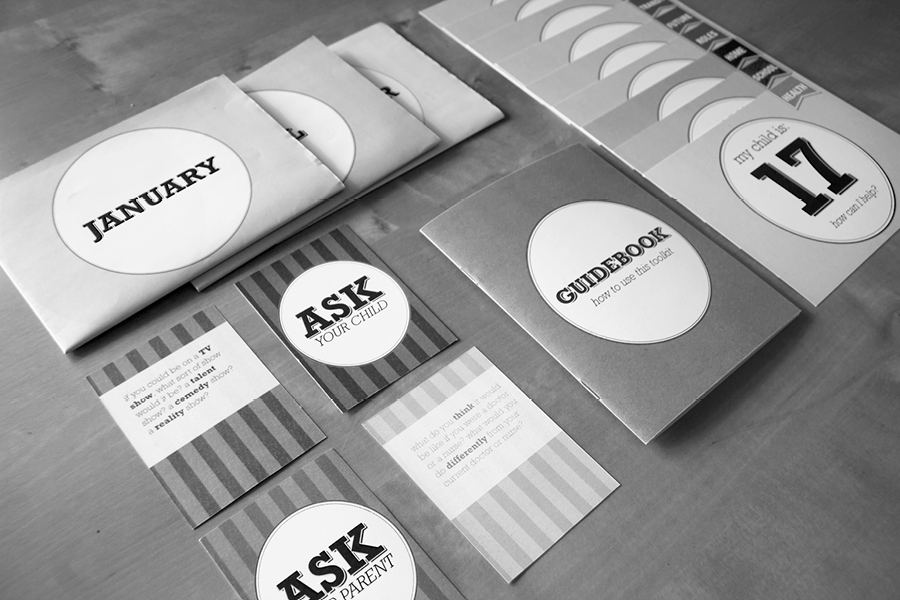A 3rd year communication design class considered the problem of youth with chronic illness transitioning from child-centred to adult-centred healthcare. Current systems have focused on paper or web-based education and information recording, but compliance rates are low. In conjunction with the British Columbia Children’s Hospital the class conducted primary and secondary research and proposed solutions.
Children with chronic illnesses are well cared for in British Columbia; they receive excellent care at the British Columbia Children’s Hospital (BCCH) in Vancouver. Children, however, are not necessarily well equipped to make the transition from child-centred to adult-centred healthcare. As children, they have access to many supportive environments; adults are responsible for their care. As adults, they are expected to manage this care on their own—a task for which many have not been adequately prepared. Various initiatives are in place to ease this transition, but none are completely satisfactory. Much of the materials are print-based, with many charts and tables that need to be completed by the youth. Some of the materials seem designed for a younger or older audience. None of it seems to “fit” today’s 18 year old. Other initiatives are online-based, but they too have had only partial “buy-in” from youth. Representatives from the BCCH approached me in the summer of 2011 with the goal of considering this problem from a communication design perspective. I agreed to offer it as a major research project for my 3rd year communication design class.
Design problem
The class was asked to consider the following problem: using any of the tools and techniques of design research discussed in this class or others, consider solutions to the problem described above. If you find that media preferences are fundamentally different between youth and their caregivers, what media would you choose? To whom should your design be directed? Are you leading the group or following their preferences? If your research suggests that youth engagement is the problem, how could you change the design to effect that engagement? In other words, how will you ensure the “buy-in” from this demographic? This complex problem has no single simple solution; it has many conflicting perspectives and requirements. Decide how you would proceed to solve the problem.
Methodology
Using a variety of techniques—primary and secondary research; co-creation; human-centred design; brainstorming; emotional probes; demographics; etcetera—students considered the problem. While access to youth with chronic illness in transition was limited, students did create co-creation toolkits and ethnographic probes. These were used with a more general population, so results will need testing and further research, but the process itself is valid and revealed many different possible design directions. These included: gaming metaphors in a web site to maximize usage and retention; expansion of health self-care education to the general population in high school; community-focused websites that facilitate the creation of support groups and communication with others with similar issues; parent-centred education; customizable iPad apps that facilitated self-care. Two of these directions are outlined below by student creators.
Case Study 1
Author: Craig Fleisch
Project title: UConnect
Project members: Craig Fleisch, Saba Taghvai-Arabi, and Paul Rarick
Our team proposed that youth would be better able to manage their chronic illness and gain independence and responsibility for their own healthcare needs by incorporating their individual experiences with a user-controlled platform such as a mobile app or social
media site.
To support our thesis, we looked through secondary research that focuses on the role of design research in healthcare and existing successful social media platforms. We also looked at the benefits and risks of social media in healthcare, and how it can engage and empower patients.
Our primary research included a cultural probe in the form of a survey. It consisted of a six-page interactive survey in PDF form. Thirty eight participants, ranging in age from 18 to 24, completed the survey. The results show that youth are constantly engaged with one another online; the majority of them have access to a laptop or smartphone. Ninety-seven percent are not satisfied with the current healthcare system, with two-thirds saying they would use a health-focused social media site. There is a clear demand for social media to play a role in healthcare.
Analysis of our primary and secondary research showed the tenability of our thesis and informed the final design. We created a health-focused social media website on a simple, easy-to-navigate platform.(image 2) Key features include personal health biographies and a place to share similar experiences with either a friends list or a forum-based online community. Users also had the option to control privacy settings, as well as search for health-related articles, research, treatments, symptoms, and conditions.
We chose to incorporate a web-based mobile app to complement the website. The app employs only a few key features of the website, including search options for symptoms, treatments, and conditions, as well as a messaging centre to get in touch with friends and healthcare professionals.
The core values of the website and app are patient engagement and empowerment. Therefore, we named our project UConnect– A place to learn, share & grow. Ideally, a health-focused app or social media site will act as a starting point for engaging individuals, and grow into a support network that can remain with them throughout their adult lives.

Case Study 2
Author: Katherine Pihl
Project title: Pushing Independence
Project members: Katherine Pihl, Natalie Straub, and Daisy Aylott
Our group proposed that children attending BCCH have difficulties transitioning to adult healthcare systems because they are not adequately prepared for adulthood. Our secondary research on parenting indicates that some parents, nicknamed “helicopter parents,” hover over their children, paying extremely close attention to them and their needs. Over time, these parents get involved in, and eventually take over, their children’s responsibilities.[1] Our group suggests that this “helicopter” behaviour has extended into the realm of healthcare, with parents making appointments for and attending medical sessions with their children. These children consequently become more reliant on their parents, as they are subconsciously aware that their parents will take care of them.
According to Hara Estroff Marano and Lenora Skenazy, this overprotection occurs because parents are anxious about turning responsibilities over to their children, because they do not believe that their child will be able to handle it.[3] Jim Taylor suggests that if parents provide a variety of opportunities for their children to be independent, and if they address their children as if they are capable of completing these tasks, both parents and children will gain confidence in the children’s abilities.[4] Other studies support these parenting theories, demonstrating that in order to raise self-reliant children, parents need to be both flexible and demanding.[2] Drawing from this research, we proposed to educate parents by providing them with a toolkit to help raise independent children.
This toolkit, named Pushing Independence, consists of four components that guide parents through various family-oriented activities that will facilitate independence in their children.
The first element of our toolkit, a guidebook, describes how our toolkit can help parents, and explains how to use the different components of Pushing Independence.
The second component is advice cards. These postcard-sized cards are categorized into three age groups, 12, 14, and 17, which are then divided into three themes: school, home, and health. The front of the cards show for whom the tips are applicable, and the back of the cards list helpful suggestions and explanations of what goals the tips aim to achieve. The advice suggests activities that centre on two goals: providing opportunities for the child to act independently and facilitating connection and conversation between parents and children.
The third component is “ASK” cards that help facilitate conversations between family members.(image 2) These small cards are divided into two categories: “ASK your child” and “ASK your parent.” A child will grab an “ask your parent” card and vice versa, and ask the question written on the back of the card. These questions revolve around independence and provide an opportunity for parents and children to openly and specifically discuss independence.
For the last component of our toolkit, we included a few calendars. By encouraging the child to write down their future plans, their daily activities, or even whether they took their medication that day, the calendars will help the child to be more organized and responsible. Since we only provided a few calendars, we hope that parents will purchase or make their own calendars.
We hope that with further development, our toolkit will encourage parents to raise their children independently, easing their transition from youth to adult-centred healthcare. We have not covered the problem of what parents should do if their child is reluctant to engage with them or the suggested activities. We did not consider how to get a child interested in being independent or interested in their healthcare.
Our aim, however, was to create step-by-step advice for raising independent children, which we have achieved; further research and development will improve the outcomes of
our toolkit.

References
- [1] Dr Sandy Whitehouse, Transition Medical Lead and Mary Paone MSN, Transition Initiative Coordinator
Case Study 1
- Sarasohn-Kahn, Jane. “The Wisdom of Patients: Health Care Meets Online Social Media.” California Health Care Foundation. April (2008): 1-24. Print.
- McKay, Lauren S. “A Prescription for Social Media.” Customer Relationship Management no. 18. October (2010): 18-24. Print.
Case Study 2
- [1] Lum, Lydia. “Handling ‘Helicopter Parents.’” Diverse: Issues in Higher Education 23.20 (2006): 40-42. Academic Search Premier. EBSCO. Web. 25 Oct. 2011. <http://search.ebscohost.com/login.aspx?direct=true&d b=aph&AN=23188035&site=ehost-live>
- [2] Myers, David G. Psychology. New York: Worth, 2010. Print.
- [3] Skenazy, Lenora. “Why Parents Should Stop Overprotecting Kids and Let Them Play.” American Journal of Play 3.4 (2011): 423-42. Print.
- [4] Taylor, Jim. Positive Pushing: How to Raise a Successful and Happy Child. New York: Hyperion, 2002. Print.
